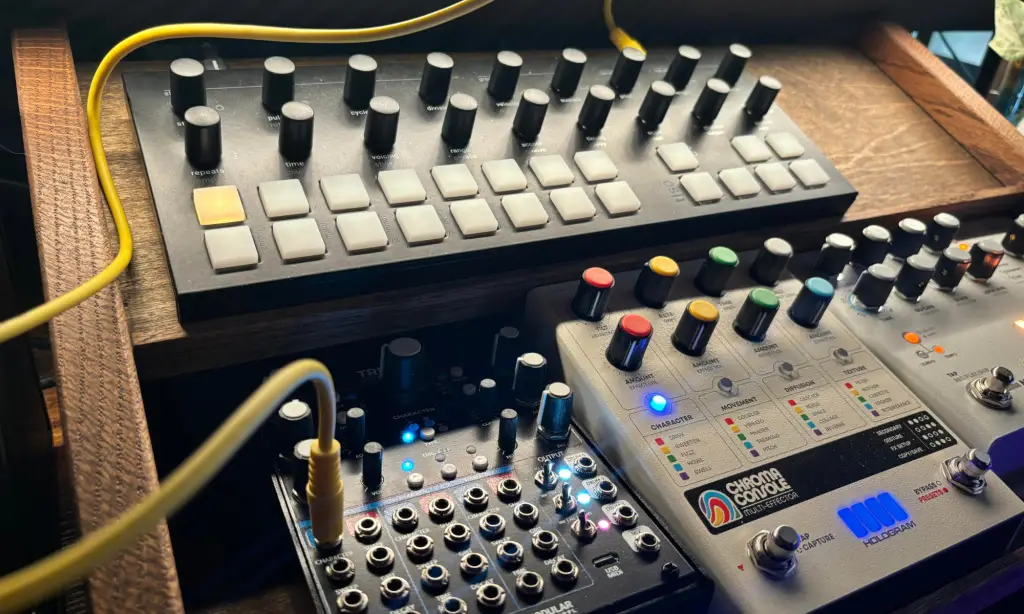Table of Contents
Modular synths, and by proxy, the modular community, are intimidating. Anyone who says otherwise is trying to flex, and you can’t convince me otherwise. Maybe I’m just projecting a bit, but it’s how I felt the second Modbap’s Trinity Drum Synth came across my radar (albeit late, as it was initially released in 2022).
But as a dance and club music producer, I’m always looking for tools and toys that make AMAZING percussions (triple the amount of bonus points if it can make a fantastic kick drum). The fact that this little device focuses specifically on making percussions made me give it a bit more attention than I would any other piece of modular gear. Couple that with Trinity’s ability to operate as a complete lone wolf without the need for other modular units, and I figured if there were ever an approachable way to dabble in modular and have a chance of getting something I’d actually be able to use in a track out of it; it would be with this.
So, I tried it out in the studio for a month before writing this in-depth and comprehensive Trinity Digital Drum Synth review, which covers everything from what this thing is to my favorite parts about it, who I think it’s designed for, and a few extras along the way.
So buckle up cause there’s a lot to cover, so we better start diving in…
What Is The Trinity Digital Drum Synth?

TRINITY is a 3-channel Digital Drum Synth Array designed for eurorack synthesizers, offering a range of drum synthesis capabilities. It includes three powerful drum voices within a 20hp module, utilizing analog-inspired, additive, FM, and noise synthesis algorithms. Each channel has its own trigger and v/oct inputs, with extensive CV input options, controlled by 7 knobs and 4 mini-pots for parameters like Pitch, Sweep, Time, Shape, Grit, Decay, EQ, Clipper, Hold, Volume, and Character. The module also features a switchable output matrix for flexible routing and USB MIDI for easy integration with other devices.
The drum synth algorithms include BLOCK (analog-inspired), HEAP (additive), NEON (FM), and ARCADE (noise), providing a variety of drum sounds from traditional electronic drums to more experimental and percussive noises. TRINITY’s cycle modes can be enabled per channel, including ‘Round Robin’ and ‘Random’, to switch drum synth types or generate random sounds with each trigger. The stack modes allow channels to be grouped and triggered, creating layered drum effects similar to the unison mode on a traditional synthesizer.
TRINITY measures 20hp in width and 28mm in depth, with power requirements of 153mA +12V and 7mA -12V (160mA peak on power up). It includes two dozen CV inputs, a clipping limiter, a mix output, and individual outputs. The module supports three-voice drum polyphony and features modes for stacking, cycling, and randomizing drum sounds. It also supports MIDI over USB to control parameters via a single USB cable.
Now that the techy specs are out of the way let’s dive into the more fun parts of the review by discussing what impressed me most about this device and what could have been improved before eventually going over the ideal types of producers and artists this module is fantastic for.
But before we get into that, we have an award to give out…
Editor’s Choice Awards

Last year, we launched our Editor’s Choice Awards for some of the best and most inventive products in the music production space. We reserved this coveted award for only the gear that pushes the boundaries and that do something new and truly exciting.
Congrats to the Modbap Team!
Modbap and their Trinity Digital Drum Synth surpassed that standard. While we will unpack many of the reasons why throughout this comprehensive review, for now, it is worth highlighting early on that this little drum synth is a class act and well-deserving of our Editor’s Choice Award badge.
Trinity Digital Drum Synth Review: The Pros
It’s DAW (And Beginner) Friendly

Modular synthesis is pretty intimidating for somebody looking to get into it for the first time. You usually have to have a handful of different devices and modules to play around with, and even still, it takes a minimum of six months or more before you can make anything halfway listenable from it.
But that’s not the case with the Trinity Digital Drum Synth, which can be fully operated independently without needing other modules. It benefits from being part of a more extensive setup (especially when paired with other Mod Bap modules). Still, it works with your DAW right out of the box, making it a fantastic device for those newly into modular synthesis or those who want something to plug patch cables into and immediately start getting sounds they can use in their music.
To be honest, I’m shocked that more units don’t do something similar, as it is one of Trinity’s best and most impressive features.
It’s Got A MASSIVE Range Of Sounds
The Trinity Digital Drum Synth is incredibly diverse in what drum sounds it can produce.
And I don’t necessarily mean that it can create an entire drum kit of sounds; it only shines in making kick drums (and toms to an extent), snares/claps, and hats. However, within the confines of these three types of percussions, you get an unreal amount of flexibility.
This is due mainly to the different saturation types and coloration. While I’ll dive into how great the saturation sounds in the next section, I want to highlight how much mileage and breadth on tonality you can get from this small device here.
Modbap’s company tagline is “Made for Eurorack, Dope Enough For Boombap!” and the Trinity undoubtedly lives up to this cheeky tagline. I found myself leaning more towards using it on cleaner, rounder 808-style kicks for the styles of dance music that I mainly produce (example and shameless plug below), but driving the Character and the Grit parameters could almost instantly change the same sound into a chunkier bass drum reminiscent of the golden days of West Coast hip-hop.
Modular isn’t something I’d always associated with hip-hop, but Trinity has something to lure in sound-designing techno aficionados and beatmakers alike.
The Saturation Is Tasty

I hinted at my love for the different types of colorations you can get from this in the section above. Still, it deserves its section entirely, as the Character, Grit, and Shape parameters on the Trinity do an obscene amount of heavy lifting regarding what you get out of this synth.
Of course, I could explain the nuts and bolts of these different parameters. Still, it would probably be easier to drop some different audio examples of how great things effects sound on a kick drum (which was by FAR the drum voicing I found myself using the most with this).
Character
Here is a simple 4×4 kick pattern that starts with a fairly stock-sounding 808-style kick drum. Listen to how much angrier the sound gets as I slowly sweep the Character knob from 0-100.
Grit
Here is the same 4×4 drum with the Grit parameter sweeping from left to right.
Even looking at the loop’s waveform, you can see how drastically this single effect can change and shape a signal. This would be a great way to remove the bass from the kick drum during a breakdown or build before sweeping the Grit down and reintroducing the sub in a more dance-focused section of an arrangement!
Shape
While not so much about saturation, Shape was a parameter I found myself reaching for a ton when I needed to really mold the kick drum into something that worked perfectly with a bassline that I was working with. This is mainly because it really affects the transient and punchy of the kick, making it a critical parameter to dial in when sculpting a low-end groove.
Where before, when I relied solely on samples to make my kicks, I would have to scroll endlessly through my sample library for the perfect kick drum for the bass that I was using. It’s always been an incredibly uninspiring process, as I’m sure you producers out there know. Hence, the ability to have complete control over the kick and mold it to the bassline and the rest of the track through the synth was a breath of fresh air.
…And The Con
Front-Facing Ports And Inputs

This is probably anecdotal evidence, as I don’t own many other modular pieces at the moment and have meticulously arranged my studio so that there aren’t many loose cords or wires floating around my main workspace. However, the fact that the USB MIDI input is on the front of the unit instead of located on the back is a little ergonomically clunky to my specific setup.
It would have been awesome to see secondary outputs and the MIDI input on the back, like the rest of my studio’s synths, sequencers, and multi-effect pedals, to keep the whole setup streamlined and organized. Of course, this is far from a dealbreaker and only a minor grievance, seen more as a first strike and far from a third, but I wanted to mention it regardless to keep this review as comprehensive and in-depth as I could.
Who Is The Trinity Digital Drum Synth For?
Gear Collectors

You don’t need to be a modular nerd to get the most out of this small device, and its ability to operate entirely independently is a fantastic reason why gear collectors should consider buying it.
Whether you have smaller sequencers, like the Torsoe sequencer I use, or other semi-modular synths like my Behringer or Korg, it can be a really fun device to plug and play with other things in the studio. And the fact that it’s relatively small – only the size of a guitar pedal, really – means that it won’t hog up a ton of real estate on your studio desk!
HipHop Producers
I may sound like a boomer when I say that my favorite part of hip-hop is the texture of a track’s percussion, which was evident by necessity back when all music was mixed and produced on inaccessible consoles. However, the fact that much of new-school hip-hop uses so many clean and “perfect” sounding samples means that much of that texture and grit is gone in modern releases in the genre.
But with the Trinity’s many colorization options, you can produce kicks, claps, hats, and more that have all the characteristics of a “modern” sound, like punchy subs and crispy highs, but still have all the character and texture of the beats of yesteryear.
It’s a fantastic and accessible way for all beatmakers to get the best of both worlds.
Dance-Music Makers
This is my niche as a producer, and I will be the first to admit that this is a fantastic tool for anyone making club music, especially those struggling to find the perfect kick in their track. The amount of molding and shaping you can do with this device to dial in the kick drum so that it meshes perfectly with your bass line and the rest of your drums are second to none.
Sure, I like the high percussions it can create, especially when playing around with the decay and sweep parameters to create little flourishes of excitement in my hi-hats, but the real X-factor here for club music makers is the kick drum engine. It’s genuinely next-level and is my new go-to way of never having to scroll through kick samples on Splice again endlessly.
Final Thoughts
The TRINITY Digital Drum Synth stands out for its versatility and ease of use within the modular synthesis community. Despite the often intimidating nature of modular setups, TRINITY simplifies the process by offering a self-contained unit capable of generating a wide range of percussive sounds without additional modules. This makes it accessible for beginners and experienced producers looking to integrate modular synthesis into their workflow. Its ability to function independently or as part of a more extensive setup ensures flexibility for various production needs.
The module excels in producing diverse drum sounds through its four distinct synthesis algorithms: BLOCK, HEAP, NEON, and ARCADE. Each algorithm brings unique characteristics to the table, allowing users to create anything from traditional electronic drum sounds to experimental percussive noises. TRINITY’s extensive control options, including knobs and CV inputs, provide precise manipulation over parameters such as pitch, decay, and character. The switchable output matrix further enhances its performance capabilities, making it suitable for live performances and studio work.
TRINITY’s integration with DAWs via USB MIDI is a significant advantage, offering seamless connectivity and control. Its compact size and thoughtful design ensure it fits well within any studio setup. The module’s ability to produce high-quality sounds across different drum types and intuitive interface make it an ideal choice for producers in various genres, including hip-hop and dance music. Overall, TRINITY offers a killer solution for those looking to explore modular synthesis without the usual complexity, providing a valuable tool for creating innovative percussive elements in music production.
The post Trinity Digital Drum Synth Review: An Insanely Accessible Way To Do Modular That Actually Sounds Good appeared first on Magnetic Magazine.



